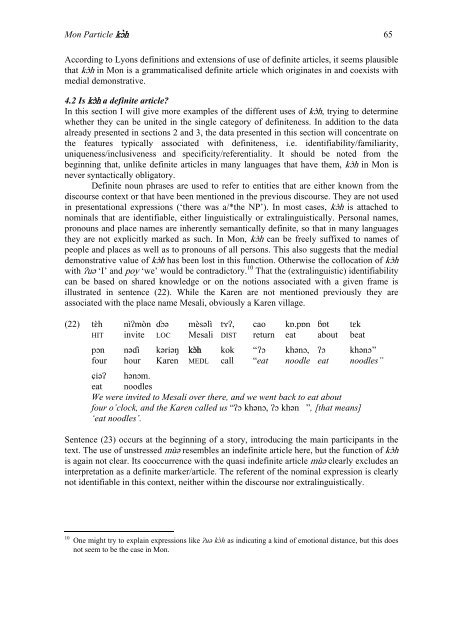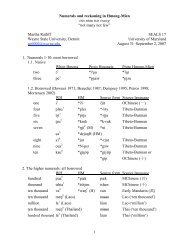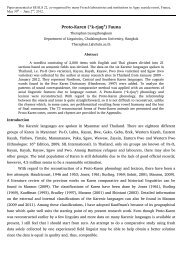proto-southwestern-tai revised: a new reconstruction - seals 22
proto-southwestern-tai revised: a new reconstruction - seals 22
proto-southwestern-tai revised: a new reconstruction - seals 22
Create successful ePaper yourself
Turn your PDF publications into a flip-book with our unique Google optimized e-Paper software.
Mon Particle kɔ̀h 65<br />
According to Lyons definitions and extensions of use of definite articles, it seems plausible<br />
that kɔ̀h in Mon is a grammaticalised definite article which originates in and coexists with<br />
medial demonstrative.<br />
4.2 Is kɔ̀h a definite article?<br />
In this section I will give more examples of the different uses of kɔ̀h, trying to determine<br />
whether they can be united in the single category of definiteness. In addition to the data<br />
already presented in sections 2 and 3, the data presented in this section will concentrate on<br />
the features typically associated with definiteness, i.e. identifiability/familiarity,<br />
uniqueness/inclusiveness and specificity/referentiality. It should be noted from the<br />
beginning that, unlike definite articles in many languages that have them, kɔ̀h in Mon is<br />
never syntactically obligatory.<br />
Definite noun phrases are used to refer to entities that are either known from the<br />
discourse context or that have been mentioned in the previous discourse. They are not used<br />
in presentational expressions (‘there was a/*the NP’). In most cases, kɔ̀h is attached to<br />
nominals that are identifiable, either linguistically or extralinguistically. Personal names,<br />
pronouns and place names are inherently semantically definite, so that in many languages<br />
they are not explicitly marked as such. In Mon, kɔ̀h can be freely suffixed to names of<br />
people and places as well as to pronouns of all persons. This also suggests that the medial<br />
demonstrative value of kɔ̀h has been lost in this function. Otherwise the collocation of kɔ̀h<br />
with ʔuə ‘I’ and poy ‘we’ would be contradictory. 10 That the (extralinguistic) identifiability<br />
can be based on shared knowledge or on the notions associated with a given frame is<br />
illustrated in sentence (<strong>22</strong>). While the Karen are not mentioned previously they are<br />
associated with the place name Mesali, obviously a Karen village.<br />
(<strong>22</strong>) tɛ̀h nìʔmòn ɗɔə mèsəlì tɤʔ, cao kɒ.pɒn ɓɒt tɛk<br />
HIT invite LOC Mesali DIST return eat about beat<br />
pɔn nəɗi kəriəŋ kɔ̀h kok “ʔɔ khənɔ, ʔɔ khənɔ”<br />
four hour Karen MEDL call “eat noodle eat noodles”<br />
ɕiəʔ hənɔm.<br />
eat noodles<br />
We were invited to Mesali over there, and we went back to eat about<br />
four o’clock, and the Karen called us “ʔɔ khənɔ, ʔɔ khən ”, [that means]<br />
‘eat noodles’.<br />
Sentence (23) occurs at the beginning of a story, introducing the main participants in the<br />
text. The use of unstressed mùə resembles an indefinite article here, but the function of kɔ̀h<br />
is again not clear. Its cooccurrence with the quasi indefinite article mùə clearly excludes an<br />
interpretation as a definite marker/article. The referent of the nominal expression is clearly<br />
not identifiable in this context, neither within the discourse nor extralinguistically.<br />
10<br />
One might try to explain expressions like ʔuə kɔ̀ h as indicating a kind of emotional distance, but this does<br />
not seem to be the case in Mon.





